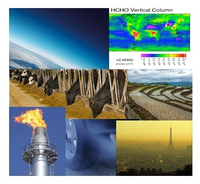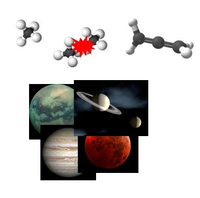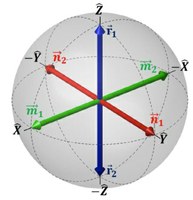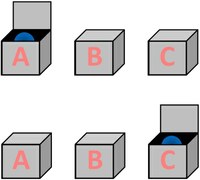Research Unit Lasers and Spectroscopies
The research unit Lasers and Spectroscopies (LLS) gathers the efforts of physicists, mainly, but also chemists and engineers, to carry out experimental and theoretical research, from both fundamental and applied perspectives. The researches focus on the development and application of laser spectroscopies to study light–matter interactions, gases, solid and liquid surfaces, as well as (bio-)organic materials, nanomaterials, atmospheric pollutants and residual gases of combustion. The LLS researchers are members of the ILEE, NARILIS, NAXYS and NISM research institutes.
From the experimental point of view, the specificity of the LLS unit is a unique expertise in the development of original homemade optical instruments, such as high-resolution spectrometers, nonlinear optical spectrometers, and optical interferometers exploiting entangled photons. These instruments rely on continuous or pulsed lasers covering the infrared, visible and ultraviolet spectral ranges. Most of the homemade instruments, as well as the commercial equipment, are integrated within the LOS technological platform. In addition to the experimental expertise, the LLS unit also develops theoretical tools, based on analytical or numerical modelling, to analyze, understand, and predict classical and quantum optical phenomena, intra- and inter-molecular interaction processes in gas phase, or physicochemical properties of molecular films at solid interfaces.
The LLS collaborates on a regular basis with other groups from the departments and the faculties of the University of Namur. Our solid international reputation leans on our innovative research in specific niches, in collaboration with many laboratories in Belgium and abroad.
The LLS covers three main directions in research:
- The study of molecules at very low concentrations (“pollutants”) in the gas phase (Muriel Lepère)
- Nonlinear optical spectroscopy of molecular and biomolecular films, surfaces, interfaces, and nanostructures
- Quantum optics and quantum weak measurements
The study of molecules at very low concentration (“pollutants”) in the gas phase
 The understanding of atmospheric physicochemical processes is a growing concern in our industrialized society, which has to deal with climate changes such as global warming or urban pollution, but also health problems such as the increase in the incidence of diseases (asthma, lung cancer…). Progress in atmospheric science requires the precise knowledge of the concentrations of many pollutants and their spatial and temporal evolution. It requires a very accurate understanding of the spectroscopic properties of gases.
The understanding of atmospheric physicochemical processes is a growing concern in our industrialized society, which has to deal with climate changes such as global warming or urban pollution, but also health problems such as the increase in the incidence of diseases (asthma, lung cancer…). Progress in atmospheric science requires the precise knowledge of the concentrations of many pollutants and their spatial and temporal evolution. It requires a very accurate understanding of the spectroscopic properties of gases.
 In general, high resolution molecular spectroscopy is a powerful tool to quantitatively investigate gas mixtures, as much for the fundamental understanding of molecular interactions than for environmental and sanitary studies. The LLS pursues relevant experimental and theoretical researches in this context. Our measurements are performed by exploiting spectroscopies based on lasers (Quantum Cascade Laser, Dual Comb Spectroscopy…) and many homemade instruments, while the modelling of the observed phenomena relies on semi-classical or quantum theories. We study line shape parameters such as individual line intensities, pressure-induced broadenings and collisional shifts, line-mixing parameters, and spectral line shape. The temperature dependence of these phenomena are also studied, because of its major impact on both fundamental studies and applications (Earth’s atmosphere, residual gases of combustion, fumes, “cold” or “hot” planets…).
In general, high resolution molecular spectroscopy is a powerful tool to quantitatively investigate gas mixtures, as much for the fundamental understanding of molecular interactions than for environmental and sanitary studies. The LLS pursues relevant experimental and theoretical researches in this context. Our measurements are performed by exploiting spectroscopies based on lasers (Quantum Cascade Laser, Dual Comb Spectroscopy…) and many homemade instruments, while the modelling of the observed phenomena relies on semi-classical or quantum theories. We study line shape parameters such as individual line intensities, pressure-induced broadenings and collisional shifts, line-mixing parameters, and spectral line shape. The temperature dependence of these phenomena are also studied, because of its major impact on both fundamental studies and applications (Earth’s atmosphere, residual gases of combustion, fumes, “cold” or “hot” planets…).
Nonlinear optical spectroscopy of molecular and biomolecular films, surfaces, interfaces, and nanostructures
 Nonlinear optical phenomena mainly arise at the high optical intensities produced by pulsed lasers. Due to the nonlinear properties of materials, light beams can interact together or change frequency, contrary to usual daily life experience. Nonlinear phenomena are tightly integrated in modern optical technologies. The LLS unit exploits nonlinear optical phenomena to produce frequency tunable lasers and to investigate light–matter interactions using spectroscopies that are specifically sensitive to surfaces, interfaces, and nanostructured materials. By selecting appropriate frequencies of laser beams, we can probe vibrational and electronic excitations of matter using sum-frequency generation spectroscopy (SFG) and second harmonic generation (SHG).
Nonlinear optical phenomena mainly arise at the high optical intensities produced by pulsed lasers. Due to the nonlinear properties of materials, light beams can interact together or change frequency, contrary to usual daily life experience. Nonlinear phenomena are tightly integrated in modern optical technologies. The LLS unit exploits nonlinear optical phenomena to produce frequency tunable lasers and to investigate light–matter interactions using spectroscopies that are specifically sensitive to surfaces, interfaces, and nanostructured materials. By selecting appropriate frequencies of laser beams, we can probe vibrational and electronic excitations of matter using sum-frequency generation spectroscopy (SFG) and second harmonic generation (SHG).

Amongst our experimental and theoretical research topics, are: investigating and determining the structure of molecular films, unravelling the orientation of molecules within self-assembled monolayers; probing the behaviour of water at the surface of (bio-)materials; understanding the physicochemical properties of biological films and the interactions between biological matter and nanomaterials; enhancing nonlinear optical signals by exploiting surface plasmon resonances; and, in general, modelling spectroscopies and nonlinear interactions of light at interfaces.
Quantum optics and quantum weak measurements
 At very low light intensities, the quantum properties of light become predominant. Discrete energy exchanges between light and matter correspond to the emission and the absorption of a photon, or even of several photons, in the case of the quantum description of nonlinear optical phenomena. In order to distinguish the classical properties of light (electromagnetic waves obeying Maxwell’s equations) from its quantum properties, the LLS measures the intensity correlations of light after the propagation of entangled photons in optical setups, such as interferometers. The coincidence counting of detection events relies on four photon counting detectors. The LLS exploits techniques, such as quantum tomography and the measurement of the violation of Bell’s inequalities, in order to study entanglement within optical systems, in particular as a function of their interactions with matter.
At very low light intensities, the quantum properties of light become predominant. Discrete energy exchanges between light and matter correspond to the emission and the absorption of a photon, or even of several photons, in the case of the quantum description of nonlinear optical phenomena. In order to distinguish the classical properties of light (electromagnetic waves obeying Maxwell’s equations) from its quantum properties, the LLS measures the intensity correlations of light after the propagation of entangled photons in optical setups, such as interferometers. The coincidence counting of detection events relies on four photon counting detectors. The LLS exploits techniques, such as quantum tomography and the measurement of the violation of Bell’s inequalities, in order to study entanglement within optical systems, in particular as a function of their interactions with matter.
 The resounding progress of quantum information research, due to its potential or established applications, such as quantum computing and quantum cryptography, has led to a regain of interest for investigating questions pertaining to the foundations of quantum mechanics. In this context, the LLS develops research in connection to quantum weak measurements. A standard quantum measurement typically perturbs strongly and irreversibly the quantum state of the system. A weak measurement partly aims at making this perturbation negligible. In this case, the experimental observations depend on a complex grandeur, known as a weak value. The LLS studies the interpretation and the modelling of weak values. On the one hand, our research deals with questions probing the foundations of quantum mechanics, including paradoxical aspects, such as the three-box paradox or the quantum Cheshire cat. On the other hand, weak measurements enable us to perform high resolution measurements, especially for optical systems. For example, the LLS studies the small deviations of the laws of propagation of light beams from the laws of propagations of isolated light rays (geometrical optics), of which the Goos-Hänchen shift is a manifestation.
The resounding progress of quantum information research, due to its potential or established applications, such as quantum computing and quantum cryptography, has led to a regain of interest for investigating questions pertaining to the foundations of quantum mechanics. In this context, the LLS develops research in connection to quantum weak measurements. A standard quantum measurement typically perturbs strongly and irreversibly the quantum state of the system. A weak measurement partly aims at making this perturbation negligible. In this case, the experimental observations depend on a complex grandeur, known as a weak value. The LLS studies the interpretation and the modelling of weak values. On the one hand, our research deals with questions probing the foundations of quantum mechanics, including paradoxical aspects, such as the three-box paradox or the quantum Cheshire cat. On the other hand, weak measurements enable us to perform high resolution measurements, especially for optical systems. For example, the LLS studies the small deviations of the laws of propagation of light beams from the laws of propagations of isolated light rays (geometrical optics), of which the Goos-Hänchen shift is a manifestation.
Principal investigators
- Prof. Muriel Lepère, director, full professor and honorary research associate of the F.R.S.-FNRS muriel.lepere@unamur.be
- Prof. Francesca Cecchet, research associate of the F.R.S.-FNRS, francesca.cecchet@unamur.be
- Prof. Yves Caudano, research associate of the F.R.S.-FNRS, yves.caudano@unamur.be









